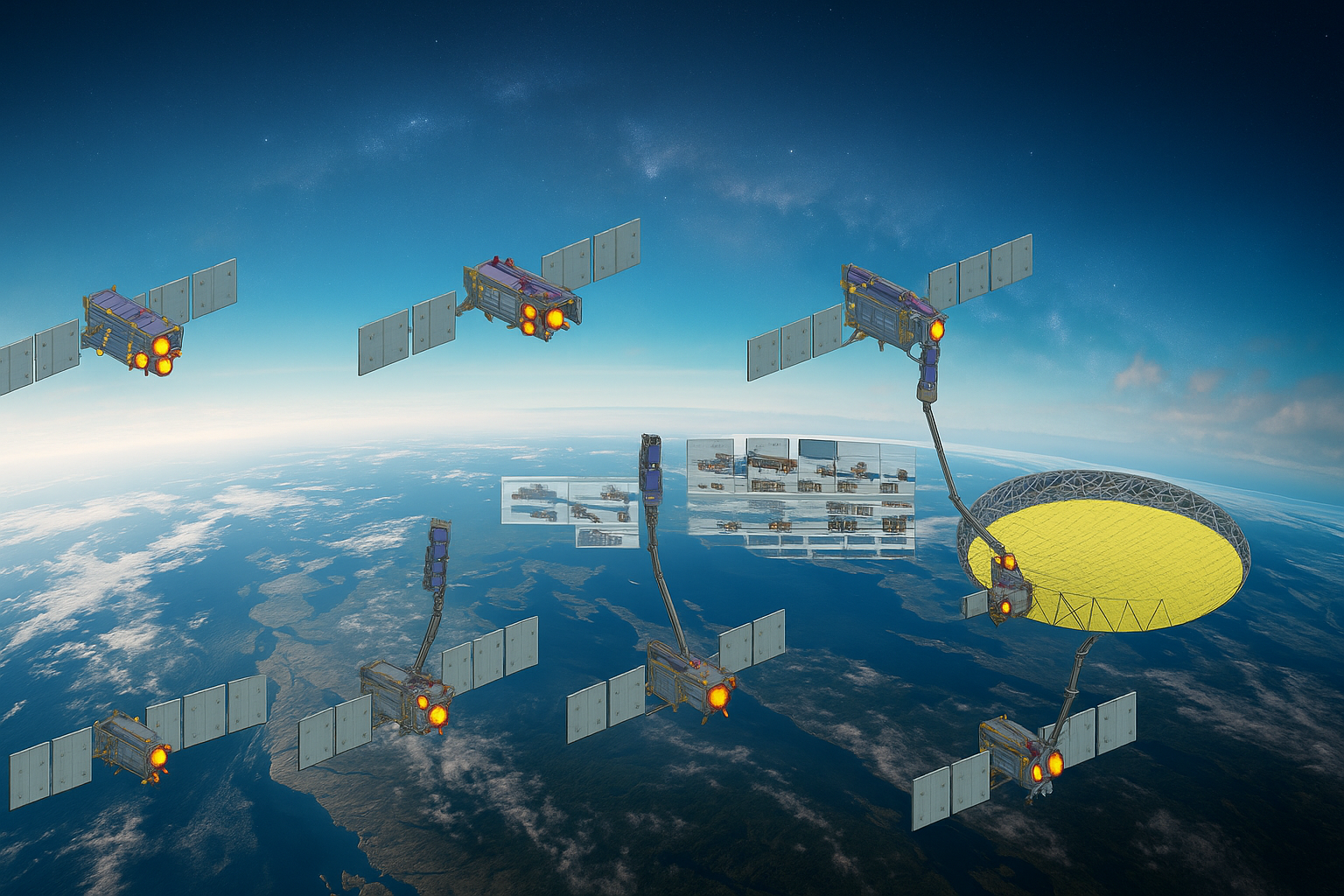
The NASA-ISRO Synthetic Aperture Radar (NISAR mission) satellite represents a groundbreaking advancement in space research and satellite missions. As a joint effort in ISRO-NASA collaboration, NISAR is set to revolutionize Earth observation with its cutting-edge radar technology.
Ahead of tomorrow’s highly anticipated launch, this NISAR satellite mission promises unparalleled insights into our planet’s dynamics, from disaster monitoring to climate change assessment.
Developed through international collaborations between NASA and ISRO, NISAR mission combines dual-frequency radar systems to provide all-weather, high-resolution data, making it a pivotal tool for global scientific and practical applications.
Understanding the NISAR Mission
The NISAR satellite is the world’s first dual-frequency synthetic aperture radar (SAR) mission, jointly developed by the Indian Space Research Organisation (ISRO) and the National Aeronautics and Space Administration (NASA).
Weighing 2,392 kg, this satellite mission integrates NASA’s L-band SAR and ISRO’s S-band SAR, utilizing a massive 12-meter unfurlable mesh reflector antenna. This innovative setup allows NISAR mission to scan the entire globe every 12 days, delivering high spatial resolution data over a 242 km swath using SweepSAR technology for the first time.
Key Features of NISAR’s Radar Technology
NISAR’s radar technology stands out due to its ability to operate in all weather conditions, day or night. The dual-band system—L-band from NASA and S-band from ISRO—enables the detection of subtle changes on Earth’s surface, such as ground deformation, ice sheet movements, and vegetation dynamics.
This radar technology employs advanced SweepSAR techniques, providing wide-swath imagery with resolutions ranging from 5 to 100 meters. Unlike optical satellites, NISAR mission microwave imaging penetrates clouds and darkness, ensuring continuous monitoring of critical areas like polar ice caps, forests, and urban zones.
Mission Objectives and Global Impact
The primary objectives of the NISAR mission satellite include studying land and ice deformation, ecosystem changes, and oceanic regions. It will measure woody biomass variations, track crop extents, monitor wetlands, and map ice sheets in Greenland and Antarctica.
Additionally, NISAR will characterize surface deformations related to earthquakes, volcanoes, landslides, and subsurface changes in aquifers or hydrocarbon reservoirs. This data will be freely accessible within one to two days of observation, democratizing space research and aiding developing nations in disaster response and sustainable development.
The ISRO-NASA Collaboration: A Milestone in International Partnerships
The ISRO-NASA collaboration on NISAR exemplifies successful international collaborations in space research. Over a decade in the making, with a joint investment exceeding $1.5 billion, this satellite mission merges the strengths of both agencies. NASA provides the L-band SAR, high-rate telecommunication subsystem, GPS receivers, and the deployable 12-meter antenna, while ISRO contributes the S-band SAR, spacecraft bus, GSLV-F16 launch vehicle, and launch services.
Workshare and Technological Contributions
ISRO’s I-3K modified satellite bus forms the backbone of NISAR, supporting a 70V power system and three-axis stabilization. The integrated radar instrument structure (IRIS) was assembled at NASA’s Jet Propulsion Laboratory (JPL) before delivery to ISRO for final integration at the U R Rao Satellite Centre (URSC). This collaborative model ensures seamless operations, with ISRO handling satellite commanding and NASA providing orbit maneuver plans. Such international collaborations not only enhance technological capabilities but also position India as a key player in global space research.
Broader Implications for Indo-US Space Ties
As highlighted by Union Minister Dr. Jitendra Singh, the NISAR satellite mission upscales ISRO’s international collaborations and sets a global benchmark for Indo-US scientific partnership. Dr. Jitendra Singh described NISAR as “India’s scientific handshake with the world,” aligning with Prime Minister Narendra Modi’s vision of India as a ‘Vishwa Bandhu’—a global partner contributing to humanity’s collective good. This collaboration extends beyond technology, fostering shared goals in addressing climate resilience, disaster management, and agricultural planning.
Technological Innovations Driving NISAR Mission Success
NISAR introduces several firsts in radar technology and satellite missions, making it a true game-changer in Earth observation satellites.
Dual-Frequency SAR and SweepSAR Technology
The combination of L-band and S-band radars allows NISAR to acquire fully polarimetric and interferometric data, enabling precise measurements of Earth’s surface changes. SweepSAR technology provides high-resolution imaging over large areas, a feat previously unattainable with single-band systems. The 9-meter deployable boom positions the antenna away from the satellite, minimizing interference and ensuring optimal performance in a sun-synchronous polar orbit at 747 km altitude.
Spacecraft Configuration and Payloads
Built on ISRO’s I-3K structure, NISAR features a high-speed downlink system and solid-state recorder from NASA. The mission’s free and open data policy ensures rapid dissemination of information, crucial for real-time applications like emergency responses. With a five-year mission life, NISAR will maintain its orbit through regular maneuvers, minimizing disruptions to science observations.
Applications and Benefits of NISAR in Real-World Scenarios
NISAR’s capabilities extend far beyond traditional Earth observation, offering critical data for disasters, agriculture, and climate monitoring worldwide.
Disaster Management and Natural Hazard Monitoring
NISAR can detect small surface changes, aiding in earthquake prediction, tsunami warnings, volcanic activity tracking, and landslide assessment. Its all-weather radar technology ensures reliable data during storms or cloudy conditions, supporting shoreline monitoring, sea ice classification, and ship detection.
Agriculture and Ecosystem Monitoring
By tracking soil moisture changes, crop mapping, and wetland extents, NISAR will enhance agricultural planning and food security. It will also monitor vegetation dynamics and woody biomass, providing insights into deforestation and ecosystem health.
Climate Change and Environmental Insights
NISAR’s observations of ice sheets, glaciers, and sea ice will contribute to understanding climate impacts. Data on subsurface aquifers and hydrocarbon reservoirs will inform resource management, while storm characterization aids in weather forecasting.
NISAR Mission Phases and Launch Details
Tomorrow marks a historic day for the NISAR satellite, with its launch scheduled for July 30, 2025, at 5:40 p.m. from the Satish Dhawan Space Centre in Sriharikota. The GSLV-F16 rocket will place NISAR into a 743 km sun-synchronous orbit, marking the first time a GSLV is used for such a polar orbit insertion.
Phases of the NISAR Mission
The NISAR mission is divided into four key phases:
- Launch Phase: Lift-off aboard GSLV-F16 from Sriharikota.
- Deployment Phase: In-orbit deployment of the 12-meter reflector via a multi-stage boom.
- Commissioning Phase: A 90-day in-orbit checkout, including calibrations and instrument verifications by JPL and ISRO.
- Science Operations Phase: Five years of data collection, with regular maneuvers and calibration activities to ensure uninterrupted observations.
All systems have been checked, and the satellite is mounted on the rocket, ready for tomorrow’s launch.
Insights from Dr. Jitendra Singh on NISAR Mission
Union Minister Dr. Jitendra Singh has been vocal about NISAR’s role in elevating India’s space research profile. In a recent briefing, he stated that the mission will provide critical global data on disasters, agriculture, and climate, benefiting the entire world. Despite the ongoing Parliament session potentially preventing his presence at the launch site, Dr. Jitendra Singh emphasized NISAR’s alignment with India’s vision of global partnership. “This mission is not just about a satellite launch—it is a moment that symbolises what two democracies committed to science and global welfare can achieve together,” he remarked.
The Future of International Collaborations in Space Research
NISAR Mission paves the way for future international collaborations, demonstrating how joint efforts can tackle global challenges like climate change and natural disasters. As ISRO and NASA continue to innovate, missions like NISAR will position space research as a tool for sustainable development and international goodwill. With its launch tomorrow, NISAR is set to become a cornerstone of Earth observation satellites, inspiring new generations in radar technology and satellite missions.
In conclusion, the NASA-ISRO Synthetic Aperture Radar (NISAR) satellite is poised to transform how we observe and understand our planet. Through robust ISRO-NASA collaboration, advanced radar technology, and a commitment to open data, NISAR mission addresses pressing global needs, solidifying its status as a game-changer in space research.
Read Current Affairs relevant to UPSC

Leave a Reply